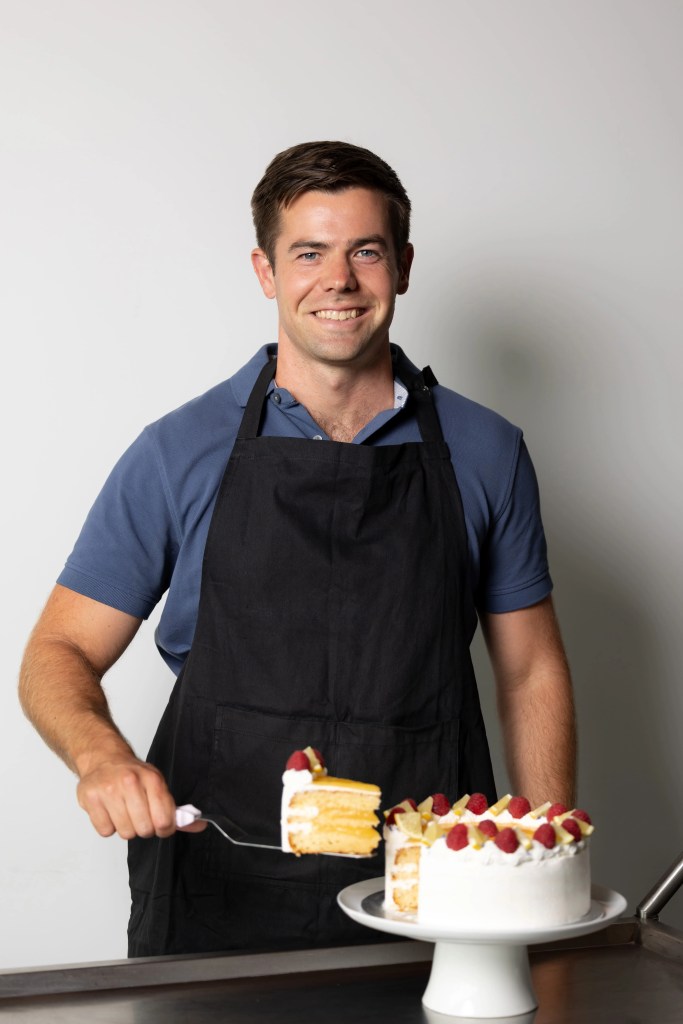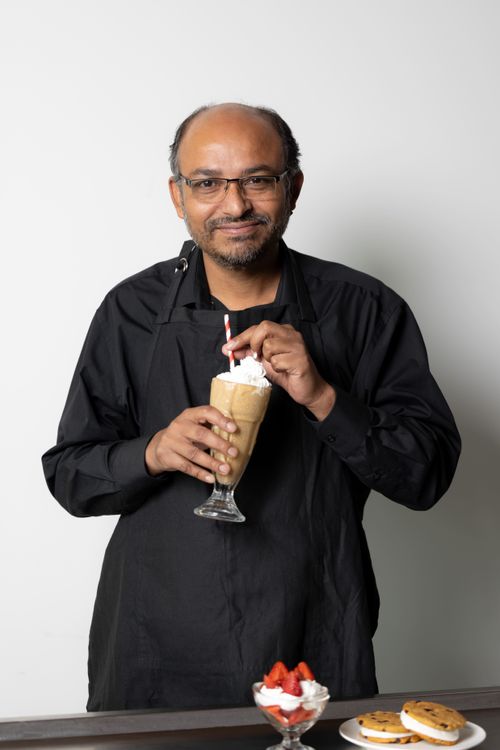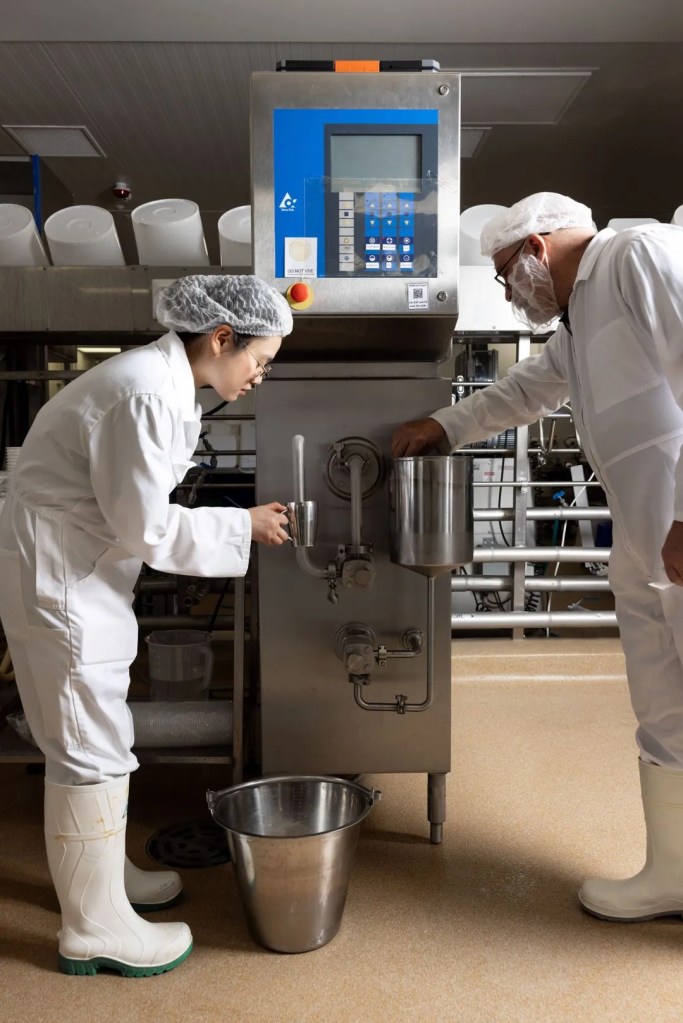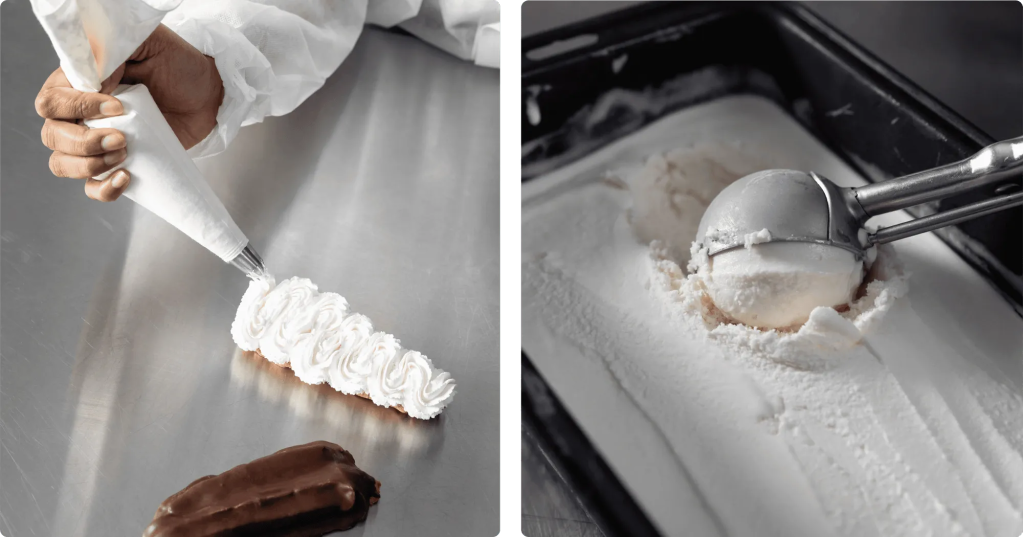New Zealand alternative dairy start-up ANDFOODS recently announced a $2.7 million raise in seed funding for its novel technology extracting plant-based milk from seeds.
Emerging from research at Massey University and the Riddet Institute, ANDFOODS says the investment round will allow the company to take its plant-based cream product to market and accelerate its R&D.
Future Alternative chatted with ANDFOODS CEO Alex Devereux about what makes the company’s technology stand out in New Zealand’s steadily growing alternative dairy sector along with his views on the industry’s future.

You started your career at Fonterra. Please share about your journey to becoming an alternative dairy entrepreneur.
When I was at Fonterra, it was straight out of university and the purpose that really drove me and the reason I was so excited to be there is because it was a fully New Zealand-owned business, and it was returning as much money to New Zealand as possible. And it was definitely the biggest New Zealand brand overseas in the food space and generally in business. It’s our largest company by a long shot. When I travel, everyone knows about Fonterra, and for good reasons.
Fonterra’s done a great job at innovating in the dairy industry, being world-class in a range of different products. And the area that I spent the most of my time in was the food service space, which at the time was Fonterra’s crown jewel. It was the fastest growing, highest margin part of the business. And it had significant investment and a lot of IP that the cooperative had built up as well.
What I started to notice towards the end of my time was this plant-based trend starting to rear its head. It was very nascent because this was still five or six years ago and it was mainly in plant based milks. You already had soy milk, which came out of China, and had made its way around the world. Almond milk out of the US had as well. And then oat milk started to rear its head. The consensus at Fonterra at the time was that these will be fads. They’re not here to stay. The nutrition’s not anywhere near dairy. We’ve got nothing to worry about.
And then as things evolved, [the plant-based milk] market just exploded and now we’re seeing it starting to trend down a little bit on the liquid milk side. And so when I was introduced to the team [at Massey University] who had developed this technology to use a novel plant material – a novel pulse crop that hadn’t been used anywhere for any value added manufacturing, let alone dairy alternatives – I was very intrigued because the part that was missing from the puzzle was the nutrition, the functionality, and the taste from the dairy alternative story.
All the applications the team could make was a dramatic improvement based on all the experience and the products that I had tried to date. That’s what got me really interested in this space because I knew from my Fonterra days that the likes of Starbucks and the big coffee and bakery chains all through Asia were already stocking plant-based milks and they were looking for other products that had the same functionality and taste characteristics that dairy did. And so that was just one of many insights that got me really excited about this opportunity.
It seems like there’s a new alternative dairy story coming out of New Zealand every week, such as with brands like Miruku, Daisy Lab, EatKinda, etc. What particular characteristics do you think makes the NZ alt dairy market stand out from other markets around the world?
I think there’s a lot of innovation in plant-based dairy and precision fermentation in New Zealand because a lot of people who start their career in food start at Fonterra. Whether they’re engineers or more on the finance, strategy, or operations side, Fonterra is a really great place to start your career. So a lot of people have this understanding of the dairy market, the nutritional profile of dairy, what it’s good for and what it’s not good for.
What happens is a lot of that expertise ends up finding its way to other peripheral projects, which often are in competing segments to Fonterra, like plant-based. And they don’t have to begin at a standing start – they’ve got a lot of information already. They can go and develop products that hit customer needs based on what they know about the dairy and non dairy categories. That’s why there’s been some really great companies, like some of which you’ve already mentioned, that have already come out of the universities and of other kinds of small start-ups.

I think what makes us different, and what gets me really excited about what we’re doing, is the technology that we’ve developed is very scalable immediately, so we don’t require really expensive equipment. And we’re using a pulse crop that is very sustainable, but also packed full of nutrition.
The reason that [pulses] haven’t been used widely before is because the taste is really horrible if you don’t process it in this particular way that we do. That’s been the real breakthrough. It’s widely available and mainly sourced in India. Two or three of our lead scientists of Indian descent, and they had this head start in discovering this material from there. It was a food they were used to growing up. It’s something that’s very common in lots of Indian cuisine.
We’ve spoken to other people who’ve come out of Fonterra, and they said their approach was to use the dairy production models that they learned from the traditional dairy industry, and apply those to, for example, precision fermentation. How you are scaling your product?
I should temper what I said [about being scalable] by saying we’re still pre-commercial. What I meant is our technology is scalable and we’re at the moment just assessing one of three different markets that we’ll launch our whipping cream into. What we’ve seen is that we’re a small company, we’ve raised 2.7 million Kiwi, which gets you to a certain point, but it’s not enough to put a lot of capex onto the ground.
The co-manufacturing network is good in some markets, but there’s not a lot of capacity for the exact setup that we will need. So right now, we’re assessing what equipment we would put into a partner’s facility to make sure we can do an end-to-end process in one space. From a ready to go and scale up perspective, that is a bottleneck.

But we have identified the shortcomings of a common co-packer and what equipment we will put in ourselves. Once we have that, we’ll be able to do all of our cream portfolio manufactured in one place for export into Southeast Asian markets and in Australia and New Zealand.
The other learning that I’ve had just from being at Fonterra is how to operate in a capital efficient, capital light manner, which often means not being too blind to things like private label opportunities. The constraint you often have is hitting a minimum run size at a third party manufacturer, launching your own brand from a standing start. You need to have a home for that product straight away.
But practically speaking, you’ve got to do all the brand building exercises and relationship and supply chain and account management. For a small company like us, that’s a lot to take on. It’s a big cost. So we will likely launch our own brand in a really narrow channel with a really small customer to start with. But looking for and executing on some of these private label conversations we have going is going to give us that ability to hit those minimum run sizes at co-packing manufacturers.
Miruku is growing dairy proteins in seeds while Daisy Labs is focused on precision fermentation. What are some of the advantages of your pulse-based approach compared to other alternative dairies?
I can only speak for the pulse that we use. Pulses generally are a really great source of nutrition and they’ve been used in modern and ancient cultures for a long time as the key source of nutrition. The other thing that is emerging more and more is their ability to replenish the soil they grow in. The crop that we source is grown in India in rotation with rice. It puts nitrogen back into the soil, which the rice then uses in its own cycle. That makes the carbon footprint emissions, land use, and water use very efficient and very attractive for scaling up.
What I like about our pulse strategy versus some of the other technologies you mentioned is that it’s scalable and it’s proven and we don’t need expensive equipment to implement it. It’s also already a common food. So achieving things like grass status in the US and other safe food statuses in other parts of the world is easier to see a path to. Because this food is already exported in its raw form, we’re not adding anything unique to the end formulation, so that step is simplified.
Nutritionally, we are able to use our side stream in a very commercial way. It’s not something like when you make oat milk, the fibre side stream you get is not great for using. For any other food application, it’s often the stock feed. We’ve seen some people use it as building material in China, but our side stream is very valuable. It’s packed full of fibre, protein and carbohydrates.
And we’re quite far developed with a range of different CPG (consumer packaged goods) companies who are experimenting with that side stream in new applications, both in high protein applications for snacking and weight loss, advanced premium pet food applications, and high protein snacking and bakery applications. So as we don’t create any waste, we can start to make our product.
We make a lot of prototypes already, so we can showcase them very easily on scale, and the manufacturing equipment we need is very common. It’s available via the Tetras of the world today.

The taste is the real secret and that’s what comes from the particular fermentation process that we use. It’s not a really complicated process, but it’s a very specific process with a very specific set of ingredients that we use to augment that flavour to be very dairy-like. Because we’re going to the food service channel to start with.
People expect a very neutral cream, for example, and we can even make it taste a little bit more like dairy because we want to go after the dairy cream and vegan cream markets. The vegan cream market’s so small – between 400 and 500 million USD a year – that I don’t think pursuing that opportunity justifies the investment that we’re looking to make.
But being able to bite into the dairy cream market is enormous. It’s still Fonterra’s crown jewel. It also has a lot of price fluctuations, which we can avoid as much as [Fonterra] has to. So there’s a lot of benefit for customers and we can give them the same functionality, taste, and mouthfeel that dairy does, which is something that they’re not used to from plant-based creams.
I think the other thing that makes us different is that we’re really chasing a texture and mouthfeel play. A nutrition composition really comes through in the side stream. We can incorporate more protein into the cream, but people don’t buy cream for its protein content. It’s really a special occasion product.
What we’re aiming for is a really great texture and functionality and that’s how firm it holds after being either pumped out of an ISL canister or whipped up in an easy mix bakery application. We’re really just listening to customers and making sure we are reflecting what they want in our products.
What do you see as the pathway to bringing consumer sentiment in New Zealand over to plant-based or alternative dairy?
New Zealand is the home of dairy and so it really isn’t a market we’re looking at strongly. Like, we will maybe launch our cream here one day. But, you know, even Fonterra doesn’t sell a lot of the UHT (ultra high temperature) whipping cream in New Zealand. New Zealand’s a fresh cream market and people are just used to making pavlova – which is a New Zealand dessert – and they put fresh cream on and kiwi fruit and strawberries.
New Zealand isn’t a place that you go and get a lot of cream on top of your coffee like you do in Asia. It’s not a big Frappuccino market, it’s not a big bakery cream market, but if it is, it’s fresh cream. It just so happens that the technology was developed here. It’s very likely that we will make and source our raw material and make our product overseas. There is a scenario where we might make some product in New Zealand, but it would just be for export.
Plant-based meat is at a turning point, with many companies either consolidating or selling their proprietary technology to large-sized companies. In your view, are the challenges plant-based dairy is facing right now similar, and do you foresee the sector moving in a similar direction?
I definitely see plant-based milks and especially oat milk at a sort of peak right now and starting to trend down. You can see that in the likes of Oatly’s financials to the public. Plant-based dairy generally has always lacked the kind of natural functionality and nutrition story that dairy has. The dairy industry has been aggressive to lobby and make sure that their nutrition story is told more compared to plant-based. And I think it’s just taken a while for the really vocal voices – whether they be nutritionists or other people who are informed – to start being concerned about the high usage of things like oat milk.
I don’t see the plant-based dairy industry contracting a whole lot. I can see plant-based milk starting to flatten a little. But what I’ve witnessed is that there’s this next generation of technology that’s taken longer to develop. Plant-based is often using pulses because of their nutritional content and sustainable sourcing story. But they’ve taken a long time to be able to be processed in really palatable, functional ways.
The material that we use, for example, is unique because it naturally has some amazing characteristics, but it’s inedible without our fermentation process. And that took a good two years of R&D from some very good food scientists to create palatable products. But this next wave of dairy alternatives I think will make a massive impact and will take a big bite out of the dairy volumes, particularly in the cream that we’re targeting.
You see a little bit in the cheese space as well. Cheese is a little harder. Cream’s always been hard because it’s such a sensitive product to get right. But we’re confident that we can make that on a commercial scale now without having to include the level of other alternative ingredients, emulsifiers, gums, and other things that other non-dairy cream companies have had to incorporate because they don’t have the technology that we do.
Overall, I think vegetarianism and flexitarianism are only growing. The meat industry has just had such a good product in terms of taste for a long time that it’s been harder to replicate that from a cell-based production perspective. Dairy is similar, but it’s more about the functionality than the taste.
Some people prefer the taste of soy or oat or almond now rather than dairy because it’s been around for so long. It’s more about getting that really stiff peak on a puff of cream or getting that stretch and melt of mozzarella. But the work in the labs around the world that I’ve seen is very impressive and I don’t think it will slow down.
Do you believe that plant-based dairy is going to see capital injection and manufacturing scale it needs in the near future?
I think the investment is going to come from strategics rather than VCs. I think VCs have been pretty badly burnt. And you hear it time and time and again that these big early stage companies ruined it for the rest of us. I completely agree. But I think they were led down a path by VCs as well to make some potentially bad choices.
The conversations that I’ve had and what I’ve witnessed from others is that the money is flowing from the strategics more and more because they’ve got the assets already. They don’t need to put new stainless steel down – they can just augment them slightly. They’ve got the distribution, they’ve got the customers. The customers are demanding different alternatives. They want non-dairy ingredients that give them the same taste, mouth feel, and texture that dairy does in a range of applications.

For example, we make a really great ice cream and chocolate caramel nougat with our ingredient formats. And we’re seeing that being very well followed and very interesting to ingredient companies because they have the commercial scale assets to make products that we would sell. So I think there’s going to be a lot more partnerships and a lot more collaborating.
People are going to have to be cautious about who they get into bed with, but also not be as arrogant as maybe they have been in the past and be willing to compromise on certain things in order to progress their technology and progress their strategies. I wouldn’t feel comfortable raising $100 million to build a new factory that I didn’t have demand for. Whereas maybe five or six years ago people were going out and doing that.
I think there’s a lot of redundant assets that can be tweaked and augmented to fulfil our needs. You see it in Australia, particularly on UHT capability and packaging capability. I think people will make use of existing assets rather than putting more greenfield sites together.
Do you think the day might come where you get a call from Fonterra or someone like them?
I’ve got so many friends still at Fonterra, and we speak about this fairly regularly, and Fonterra doesn’t have a plant-based strategy at the moment. They’d be one of the only dairy companies in the world that doesn’t. They’ve looked at it a few times. It’s a really hard one for their farmers to wrap their heads around. I hope that they do come around to it at some point. It’s not something that we are going to rely on.
We’ve spoken to a lot of other international dairy companies who have existing plant-based products and strategies, and I think Fonterra will eventually realise that to be relevant to certain customers, they’re going to have to be able to sell everything. Even if that customer wants to buy 90% dairy, they’re also going to want to buy 10% plant-based, and they’re going to want to buy it from the same people. That’s how Dannon evolved into one of these enormous plant-based milk businesses. I really hope [Fonterra does the same]. But given their capital structure, it’s a little bit harder for them.
When do you plan to launch your first commercial product?
We are very close to announcing where we will launch our first product, which will be World’s Best Whipping Cream. I’m really excited to get some real customer feedback for that. I think it’s such a fantastic product.
It took me a long time to be kind of convinced about this plant-based dairy world. I was very sceptical, and I’m now fully on board. It is just such an amazing platform to deliver the same functionality, mouthfeel, taste, and texture that dairy does, and even surpass it in some respects. The way that our cream holds on top of a frappuccino or on a bakery application is the best I’ve ever seen, better than Fonterra whipping cream. I’m really excited to see the look on customers’ faces, but also the delight on a chef’s face.
We’ve already tested [the product] with a bunch of different New Zealand chefs, and the feedback’s been really positive. And that’s something that is hard to get out of a chef, right? They’re pretty sceptical normally, so I’m just excited to see that more and more.
To stay up-to-date on the latest industry headlines, sign up to Future Alternative’s enewsletter.
Posted on:


